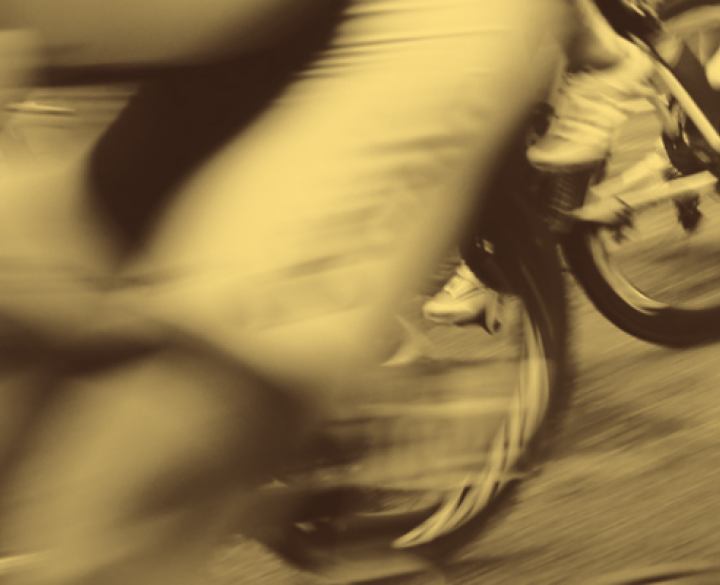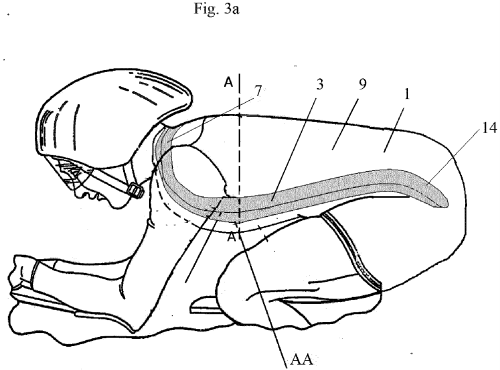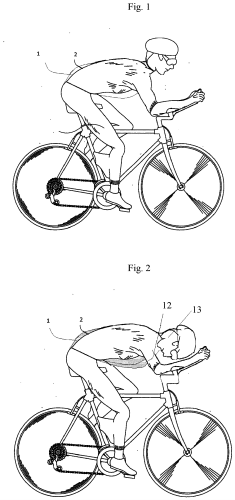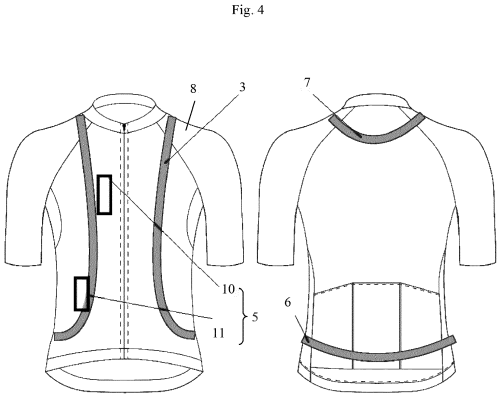Applicant: B-CELLS
Inventor: CELIS BERT RAF, B-CELLS BV
Patent application number: EP3977881 A1
Problem
The current bicycle airbags on the market do not show any aerodynamic improvements and the components are not positioned in places that can lead to lower air resistance coefficients (drag coefficients). The current cooling methods too, including phase-changing materials or fabrics leading to faster cooling by evaporation, are not specifically designed according to the aerodynamics of the racing cyclist or cyclist. In addition, the current bicycle airbags do not take into account lower bicycle positions (e.g. time trial positions) and do not use stretch fabrics that precisely follow the contours of the body and provide a close fit with the body. As a result, the current bicycle airbags cannot be used in cycle racing or in other sports where sufficient freedom of movement is required. In particular, the combination of stretchability (the ability to breathe easily and comfortably) and a tight fit around the body has not yet been created to date in existing airbags for the body.
Moreover, no patent whatsoever is found where the airbag is activated optionally from a contact sensor in the click pedals. Image analyses of bicycle accidents showed that unlocking the click pedal (at relatively high speed > 5 m/sec) is the first action and indication there will be a fall; no other patent whatsoever mentions the activation of an airbag system from click pedals.
Solution
The purpose of the invention is to provide sports clothing, for example a stretch airbag shirt or full airbag suit (shirt and trousers), which is aerodynamic and in which the airbag has been integrated, taking into account the aerodynamic resistance losses already mentioned.
The invention relates to the field of sports clothing and, more specifically, cycling clothing with a view to improving safety combined with improving performance through improved cooling and/or improved aerodynamic resistance.
More specifically, the invention described relates to inserting airbag and/or cooling products in a stretch shirt or stretch sports clothing such as a cycling suit, in which the airbag and/or cooling products are preferably located in a zone on the chest and abdomen, the pelvis and (top of the) thigh or the lower back. However, the airbag is comfortable enough, fits closely and takes cyclists' different positions into account, for example, and allows leg movement in the different cycling positions. The invention concerns a new product and the working method to create this product, which ensures, for example, that although using the product does increase the weight for racing cyclists or cyclists, it results in a reduction in air resistance (aerodynamic losses) and provides additional cooling. In addition, the invention provides better protection by also protecting the pelvis and femur. The triggers for the airbag may also use sensors in click pedals, which can trigger the airbag very early as from certain speeds. This ultimately results in the fact that the racing cyclist or cyclist is better protected, but also needs less power to move the bike forward or to be able to perform better by reducing aerodynamic resistance and improving body cooling.
To this end, the invention provides sportswear for racing cyclists that is made of stretch textile to have a close and tight fit around the body, with the characteristic that the sportswear comprises a bag for an airbag, where the bag is folded up and/or rolled up in at least a U-shape and/or S-shape, in such a way that perspiration discharge especially is hindered less.
In an embodiment, the U-shaped bag of the airbag and the airbag components are positioned on the sports clothing in such a way that the user's drag coefficient improves during use; in particular at the thorax, lower back or combinations of both.
In some embodiments, the U-shaped bag of the airbag is positioned in front over the thorax and extends to the bottom and back of the sports clothing.
The U-shaped bag of the airbag also extends to the neck to strengthen and keep the neck in position. In a further embodiment, the sports clothing is a cycling shirt or a cycling suit, wherein the U-shaped bag of the airbag runs from the cycling shirt or the shirt of the cycling suit to trousers to the top of the femur and possibly even over the thigh joint.
The U-shaped bag of the airbag comprises an electronics module and a CO2 cartridge and/or a cartridge containing gas or air at high pressure to fill the airbag, wherein the electronics module and the CO2 cartridge are positioned in an aerodynamic shape; preferably at the thorax.
The U-shaped bag of the airbag comprises an external shape in non-inflated state to increase the circumference of the thorax by approximately 1 to 30 cm, wherein the circumference is measured just below the edge of the chest.
The bag of the airbag is optionally reduced at the neck, such that the sports clothing is compatible with the helmet used.
The electronics module of the sports clothing is optionally configured to use sensors in the click pedals to trigger the bag of an airbag. The electronics module provides a Bluetooth connection, wherein the Bluetooth connection is configured to communicate with the controller of an electric bicycle or the smart lock, wherein the controller or smart lock (lock containing a controller) is configured to check up on the user to ensure that the user is indeed wearing his airbag shirt; the controller is optionally configured to provide an audible or visual signal of the Bluetooth connection to the sports clothing.
The bag of the airbag is extended over the pelvis and femur to provide protection from the femur to the knee.
The sports clothing further comprises an internal explosive, in particular NaN3 to activate the bag of the airbag, wherein the CO2- cartridge is placed externally next to the bag of the airbag and the internal explosive is activated internally in the bag of the airbag.
The user is an athlete, a cyclist or a racing cyclist, and wherein the sports clothing is clearly intended to be used in sports, wherein freedom of movement is necessary and more extreme positions are adopted and wherein repetitive movements or very rapid movements are necessary and/or for recreational cyclists or cyclists on the daily commute.
In a following embodiment, the bag of the airbag protrudes from under the shirt and extends to the pelvis and thigh joint and, as such, can be attached to matching trousers.
Advantages
- The invention provides better protection by also protecting the pelvis and femur.
- In professional bicycle racing and other sports where weight and thermoregulation play an important role in the athlete's performance, there is a need for bicycle airbags that provide a solution for this.
- This ultimately results in the fact that the racing cyclist or cyclist is better protected, but also needs less power to move the bike forward or to be able to perform better by reducing aerodynamic resistance and improving body cooling.
- On the other hand, the non-breathable or non-moisture-permeable surfaces (such as the bag of the airbag) must be minimised for adequate thermoregulation. The surface area of the bag of the airbag (which is parallel to the body) is therefore limited by folding it (in a U-shape or an S-shape).
- When the airbag bag runs parallel to the skin surface, the air and moisture discharge is limited because the bag of the airbag, as such, does not allow air or moisture to pass through and is also highly insulated.







